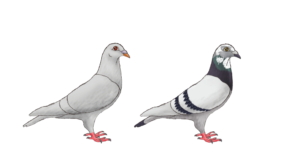I have a lot of pets and yet, it’s the racing pigeons that always fascinate me. My first encounter with them was at a local pet shop, where I accidentally bumped into a hobbyist who was selling his pair. He asked if I was interested in them, but my money then was just sufficient to buy one instead of a pair. Nonetheless, that was the turning point, and from then on, I got hooked on racing pigeons.
Memorable experiences I had:
• I always looked forward to Sundays, when I could visit the Arranque market where there was a section for buying and selling pigeons.
• As I got more adventurous, I travelled to the Malolos market to attend their market day; they had a pigeon section there, too.
• I would bring my pigeons to school, a kilometer away from home, and release them so that they could fly back to my home.
• My pigeons got stolen, but after two months, they returned.
• I met other hobbyists and gained new friends.

The Racing Pigeons
There are two categories of pigeons: racing pigeons and fancy pigeons. Fancy pigeons are entered into competitions because of their aesthetics, while racing pigeons are used for sports events in which they race home from a specific location. The fastest bird wins the race. I will focus on racing pigeons for this article.
Racing pigeons began to be popular decades ago. Since World War I and II, they were used as message carriers. Enemies always tried to shoot them down. Records show how many troops were saved because of the successful flights carried out by pigeons. Some pigeons even arrived at their destinations wounded.
They were also used by workers to carry their daily wages. Workers in the olden days walked home, and to protect their daily wages from potential thieves, they brought their pigeons to work; upon receiving their salary, they placed these inside little ‘backpacks’ attached securely to the pigeons. The workers’ wives then waited for the pigeons’ return and safely retrieved the money.
Today pigeons in general are seen as:
• Tourist attractions in places like Rome
• Symbols of peace and freedom in various events, especially the white pigeons.
• Symbols of love and fidelity in wedding ceremonies
• Sports mascots
The mystery of a racing pigeon’s ability to find its way home remains a mystery. Two popular studies indicate that pigeons rely on either on their sense of smell to find their way home or that they follow the Earth’s magnetic field lines.
Pigeon racing is a popular sport in the United States, Brazil, Europe, Canada, and Africa. Pigeon racing is also becoming increasingly popular in parts of Asia, especially China, Pakistan, Iran, the Philippines, Japan, Taiwan, and Bangladesh. Taiwan has more racing pigeon events than any other country in the world.
Your basic needs for keeping pigeons as pets or for racing are:
• Loft – this is where your pigeons will be housed. The design and location are very important.
• Feeds – you must ensure that the feeds you give them have the proper ratio of carbohydrates, protein, and fats.
• Supplements – you need to provide them with grits and multi-vitamins.
Popular pigeon colours:
• Blue bar – Blue with a black bar along the wings
• Checked – having a pattern of small squares
• Black
• White
• Pied, or having markings consisting of two or more colors
• Grizzled – This pattern is associated with the color gray
Kinds of races for pigeons:
• Street races – very popular among beginners, in these kinds of races, hobbyists within a neighborhood
compete with each other by selecting a location from 5-20 kilometers away for the pigeons to fly home from.
• Club races – in which hobbyists join a club and compete either in the north race or the south race. In the Philippines there are around 80 registered clubs.
• One-loft racing – is the process of training the birds of different hobbyists in the same loft, under the same trainer and under the same conditions. It is thought to be the fairest method of proving which bloodline is the best. The birds are all taken to the same release point and return to the same home loft.
The fastest bird to complete the race from point A to B will be the winner. Hobbyists will be able to compare their bloodlines on an equal basis against many other pigeons.
Timing methods used in the Philippines:
• Telephone system – in this obsolete system, a local phone is used to call a club once the bird arrives; the caller gives a serial code (usually attached to the bird).
• Cell phone system- using SMS, the details of the bird that arrives will be sent to the club for the results.
• Bundy clock system – involves rubber rings with unique serial numbers. The ring is attached to the bird’s leg before being sent to race. The serial number is recorded, the clock is set and sealed, and the bird carries the ring home. When the first bird returns, its trainer removes the ring and places it in a slot in the clock. The time that the ring was placed in the clock is recorded as the official time that the competing bird arrived home.
• Electronic (RFID or radio frequency identification) system – birds are fitted with a band that has a tiny RFID chip in it which can be read when the bird comes home. A bird’s arrival is recorded automatically at the home loft, where there is an electronic scanner (a pad or antenna) that records the pigeon’s arrival as it crosses the entry point to the loft.
The racing pigeon’s mystery and enjoyment creates a bond between the bird and the hobbyist. Each bird has a unique personality that only the hobbyist can identify, appreciate, and understand.
This appeared in Animal Scene’s November 2015 issue.






